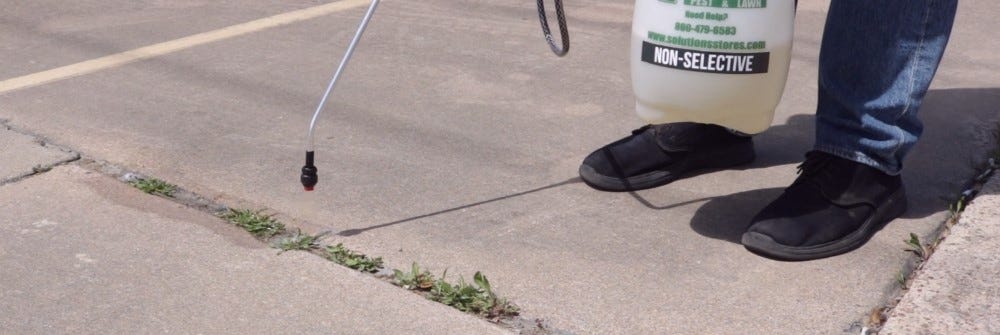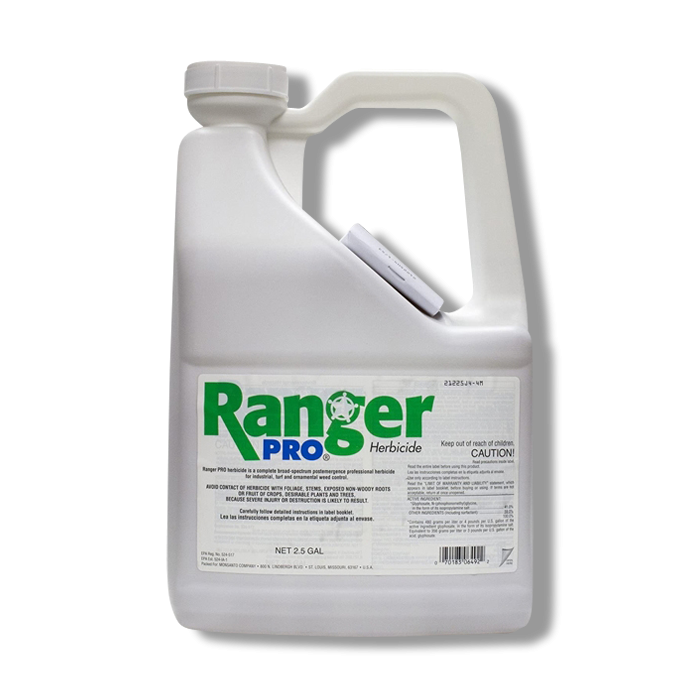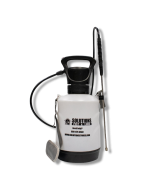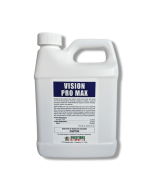Ranger Pro Weed Killer
Ranger Pro Weed Killer
Ranger Pro is a post-emergent herbicide that can successfully control a wide range of weeds and brush. It contains the active ingredient Glyphosate, the same as Round Up Pro, and is great for residential and commercial weed control. This weed killer is economically priced and easy to use.
Ranger Pro Herbicide, manufactured by Monsanto, and is a non-selective post-emergent herbicide. Ranger Pro's active ingredient is Glyphosate which shares the same formula as RoundUp Pro, but at a more cost-effective price.
Ranger Pro comes in a water-soluble formulation and also comes built-in with a surfactant, so adding additional surfactant is not necessary, but you can still optionally include other surfactants.
This is also a systemic herbicide with no soil activity, meaning it is absorbed by the target weed either from the foliage or from the root system and moves through the entire plant, killing it while sparing adjacent plants that are not contacted by the product.
Tools Needed
To apply, you will need either a backpack sprayer, handheld pump sprayer, or a professional skid sprayer for large volume applications.
How to Use

- Step 1: To figure out how much Ranger Pro Herbicide you need, you will need to first determine the size of the target area. To do this, measure and calculate the target area's length x width to get the total square footage of the area to be treated.
- For general spray-to-wet applications for annual weeds and perennial weeds, the mix ratio will be 0.5 to 10 percent solution of Ranger Pro at a rate of 2/3 fl. oz. to 13 fl. oz. per gallon of water to cover 1,000 sq. ft. Use the higher rate for weeds over 6 inches tall. Check the label for specifics rates depending on the weed you're trying to control.
- Step 2: Fill the spray tank with the required amount of water. Add the correct amount of product to the water near the end of filling the tank. If you are using a backpack or pump-up sprayer, it is suggested that the labeled amount of Ranger Pro Herbicide be mixed with water in a larger container then fill the sprayer with the mixed solution.
- Step 3: Apply the solution to targeted weeds at low pressure, spraying to wet but before the point of runoff. Use a fan nozzle spray setting for uniform and thorough coverage.
Where to Use

Ranger Pro is formulated for use on outdoor areas such as recreational areas, parks, farms, croplands, apartment complexes, Christmas tree farms, ditch banks, ornamental plant nurseries, golf courses, lumber yards, warehouses, schools, storage areas, railroads, constructions sites prior to building or laying asphalt, conservation properties, and other areas.
When to Use
Apply to control target weeds during daylight hours when the weather is sunny, warm, and calm so that the chemicals move through the weeds faster. It is also beneficial to make applications when the plants are young and actively growing.
Do not treat weeds if there is drought, disease, or insect damage as this may cause weed control to be less effective in allowing the product to soak into the foliage.
Spray on calm days when wind speeds are low to minimize accidental spray drift.
Safety Information
This is safe to use around children or pets when applied according to the product label. Always wear the proper personal protective equipment when mixing or applying Ranger Pro Herbicide (gloves, long pants, safety mask, protective eyewear).
Special Considerations
Remember that Ranger Pro is a non-selective, post-emergent herbicide and will negatively affect or kill desired plants if foliar contact is made. Always be mindful of spray drift so that you do not accidentally spray wanted turf grass or other desirable plants.
| Availability | Online |
| Restricted Use | No |
| Shipping Restrictions | 30 Gallon Drum: AK, CA, CT, HI, IN, MI, NY, OR, RI, SC, VT, WA 2.5 Gallon: No Restrictions |
| Brand | MONSANTO |
| Keith's Pro Tips | "When spraying large areas with Ranger Pro, it's a good idea to use an indicator dye to not only keep track of your spraying to avoid over application, but to also help you see any spray drift." |
| Product Drawbacks | Ranger Pro Herbicide is a non-selective herbicide so you have to be very careful when spraying it in areas where desired vegetation is in close proximity. |
| Target Pests | Ranger Pro Herbicide can control annual weeds, Perennial weeds, Brush Weeds, Tree Seedlings. Alder, American Hornbeam, Annual Bluegrass, Annual Fleabane, Annual Sowthistle, Annual Spurge, Artichoke Thistle, Ash, Bahiagrass, Barley, Barnyardgrass, Bearclover, Beech, Bentgrass, Bermudagrass, Birch, Bitter Cherry, Bittercress, Black Cherry, Black Locust, Black Nightshade, Black Oak, Black Sage, Blackberry, Blackgum, Blue Mustard, Blue Vervain, Bracken, Brackenfern, Brazilian Peppertree, Bristly Starbur, Broadleaf Signalgrass, Bromegrass, Broomsedge, Broomsedge Raspberry, Browntop Pamicum, Bulbous Bluegrass, Buttercup, California Buckwheat, California Sage Brush, California Yerba Santa, Canada Thistle, Canafa Thistle, Carolina Foxtail, Cascara, Castorbean, Catsclaw, Cattail, Ceanothus, Chamise, Cheatgrass, Cheeseweed, Chervil, Chickweed, Chinese Tallowtree, Cocklebur, Cogongrass, Common Groundsel, Common Milkweed, Common Mullein, Common Purslane, Common Ragweed, Common Rye, Corn, Corn Speedwell, Coyotebrush, Crabgrass, Crolina Geranium, Curly Dock, Dallisgrass, Deerweed, Dewberry, Dogfennel, Dogwood, Downy Brome, Dwarfdandelion, Eastern Mannagrass, Eastern Redbud, Eclipta, Elderberry, Elm, Eucalyptus, Fall Panicum, Falsedandelion, Fescue, Fiddleneck, Field Bindweed, Field Pennycress, Field Sandbur, Filaree, Fivehook Bassia, Florida Beggarweed, Florida Pusley, Foxtail, French Broom, German Ivy, Giant Ragweed, Giant Reed, Goosegrass, Gorse, Grain Sorghum, Guineagrass, Hairy Fleabane, Hasardia, Hawthorn, Hazel, Hemp Dogbane, Hemp Sesbania, Henbit, Hickory, Honeysuckle, Hophornbeam Copperleaf, Horsenettle, Horseradish, Horseweed, Iceplant, Itchgrass, Japanese Brome, Johnsongrass, Johnsongrass seedling, Jointed Goatgrass, Junglerice, Kentucky Bluegrass, Kikuyugrass, Knapweed, Knotweed, Kochia, Kudzu, Ladysthumb, Lamb's-Quarters, Lantana, Laurel Sumac, Leafy Spurge, Lespedeza, Little Barley, London Rocket, Madrone Resprouts, Mandzanita, Marestail, Mayweed, Medusahead, Milkweed, Monkey Flower, Morningglory, Multiflora Rose, Musk Thistle, Napiergrass, Oats, Orchardgrass, Pampasgrass, Paragrass, Pennsylvania Smartweed, Perennial Pepperweed, Perennial Ryegrass, Persimmon, Phragmites, Pigweed, Pin Cherry, Pine, Plains Coreopis, Poison Hemlock, Poison Ivy, Poison Oak, Poison Sumac, Poorjoe, Post Oak, Prickly Lettuce, Prickly Sida, Puncturevine, Purple Nutsedge, Purslane Speedwell, Quackgrass, Quaking Aspen, Red Clover, Red Maple, Red Rice, Redroot Pigweed, Redvine, Reed Canarygrass, Rough Fleabane, Russian Olive, Russian Thistle, Rye, Ryegrass, Salmonberry, Saltcedar, Sassafras, Scotch Broom, Scrub Oak, Shattercane, Shepherd's-Purse, Sicklepod, Sicklepot, Silver Bluestem, Silverleaf Nightshade, Smallseed Falseflax, smartweed, Smooth Bromegrass, Smooth Sumac, Smutgrass, Sourwood, Southern Red Oak, Southern Waxmyrtle, Spanishneedles, Spotted Spurge, Sprangletop, Spurge Prostrate, Spurred Anoda, Stinkgrass, Sugar Maple, Sugarbrush Sumac, Sugarbush Sumac, Sumac, Sunflower, Sunflowers, Swamp Smartweed, Sweetgum, Swordfern, Tall Fescue, Tanoak Resprouts, Tansy Mustard, Teaweed, Texas Blueweed, Texas Panicum, Texas Paniicum, Thimbleberry, Tickswwd, Timothy, Torpedograss, Toyon, Tree Tobacco, Trumpet, Trumpetcreeper, Tumble Mustard, Umbrella Spurry, Vaseygrass, Velvetgrass, Velvetleaf, Vine Maple, Virginia Copperleaf, Virginia Creeper, Virginia Pepperweed, Volunteer Corn, Western Wheatgrass, Wheat, White Clover, White Oak, White Sage, Wild Mustard, Wild Oats, Wild Sweet Potato, Willow, Winged Sumac, wirestem Muhly, Witchgrass, Woolly Cupgrass, Woolly-Leaf Bursage, Yellow Nutsedge, Yellow Poplar, and Yellow Rocket. Please refer to the product label for a complete list of target weed species. |
| Application Equipment | Backpack Sprayer, Pump Sprayer, Spray Rig |
| Application Methods | Broadcast Spray, Spot Treatment |
| Active Ingredient | Glyphosate - 41% (same active ingredient as Roundup) |
| Product Type | Herbicide |
| Formulation | Suspended Concentrate |
| Application Rate | Ranger Pro mix rates vary depending on percentage ratios of .5%, 1%, 1.5%, 2%, 5% and 10%. Ranger Pro can be mixed between 2/3 oz. to 13 oz. per gallon of water depending on the desired dilution ratio. For more specific application rates please refer to the label. |
| Shelf Life | Ranger Pro Herbicide will last 2 to 3 years in storage if kept in a cool, dry area. |
| Yield | A 2.5 Gallon Jug of Ranger Pro Herbicide at an average rate of 2 oz. per gallon, can treat up to 160,000 sq. ft. of area. |
| Use Sites | Outdoors |
| Time to Kill | Ranger Pro moves systemically through the foliage or root system. Effects are visible on most annual weeds within 2 to 4 days, but on most perennial weeds may not occur for 7 days or more. Extremely cool or cloudy weather following treatment may slow the activity of this product and delay development of visual symptoms. |
| Comparable Products | Glyphosate 4 Weed Killer, Eraser 41% Glyphosate, Roundup Pro, Gly Pho-Sel Pro |
| Incompatible Grass Types | Bentgrass, Bermudagrass, Kentucky Bluegrass, Fescue, Fine, Fescue, Tall, Kikuyugrass, Ryegrass, St Augustine, Zoysiagrass |
| EPA Registration # | 524-517 |
| Restricted Use | No |
|---|---|
| Shipping Restrictions | AK, CA, CT, HI, IN, MI, NY, OR, RI, SC, VT, WA |
| Availability | Online |
| Signal Word | CAUTION |
| Keith's Pro Tip | "When spraying large areas with Ranger Pro, it's a good idea to use an indicator dye to not only keep track of your spraying to avoid over application, but to also help you see any spray drift." |
| Target Pests Multi | Alfalfa, Alligatorweed, Anise Fennel, Annual Bluegrass, Annual Fleabane, Annual Sowthistle, Annual Spurge, Artichoke Thistle, Bahiagrass, Barnyardgrass, Bentgrass, Bermudagrass, Bittercress, Black Nightshade, Blue Mustard, Bracken Fern, Bristly Starbur, Broadleaf Signalgrass, Browntop Panicum, Bulbous Bluegrass, Buttercup, Canada Thistle, Carolina Foxtail, Carolina Geranium, Castorbean, Cattail, Cheatgrass, Cheeseweed, Chervil, Chickweed, Cocklebur, Cogongrass, Common Groundsel, Common Milkweed, Common Mullein, Common Purslane, Common Ragweed, Common Rye, Corn, Corn Speedwell, Corn Volunteer, Coyote Brush, Crabgrass, Curly Dock, Dallisgrass, Dandelion, Deerweed, Downy Brome, Dwarfdandelion, Eastern Mannagrass, Eclipta, European Beachgrass, Fall Panicum, False Dandelion, Fescue, Fiddleneck, Field Bindweed, Field Pennycress, Field Sandbur, Filaree, Fivehook Bassia, Florida Beggarweed, Florida Pusley, Foxtail, German Ivy, Giant Ragweed, Goosegrass, Guineagrass, Hairy Fleabane, Hemp Dogbane, Hemp Sesbania, Henbit, Honeysuckle, Horsenettle, Horseradish, Horseweed/Marestail, Iceplant, Itchgrass, Japanese Brome, Jerusalem Artichoke, Johnsongrass, Jointed Goatgrass, Junglerice, Kentucky Bluegrass, Kikuyugrass, Knapweed, Knotgrass, Knotweed, Kochia, Kudzu, Ladysthumb, Lambsquarters, Lantana, Leafy Spurge, Lespedeza, Little Barley, London Rocket, Mayweed, Medusahead, Milkweed, Milo, Morningglory, Multiflora Rose, Musk Thistle, Napier Grass, Oats, Orchardgrass, Pampasgrass, Paragrass, Pennsylvania Smartweed, Perennial Pepperweed, Perennial Ryegrass, Phragmites, Pigweed, Poison Hemlock, Poison Ivy, Poison Oak, Prickly Lettuce, Prickly Sida, Prostrate Spurge, Puncture Vine, Purple Nutsedge, Purslane Speedwell, Quackgrass, Quaking Aspen, Red Clover, Red Rice, Redroot Pigweed, Redvine, Reed Canarygrass, Rough Fleabane, Russian Thistle, Rye, Ryegrass, Seedling Johnsongrass, Shattercane, Shepherdspurse, Sicklepod, Silverleaf Nightshade, Smallseed Falseflax, Smartweed, Smooth Bromegrass, Smutgrass, Spanishneedles, Spotted Spurge, Sprangletop, Spurred Anoda, Stinkgrass, Sunflower, Swamp Smartweed, Tall Fescue, Tansy Mustard, Teaweed, Texas Blueweed, Texas Panicum, Tickseed Coreopsis Plains, Timothy, Torpedograss, Trumpet Creeper, Tumble Mustard, Umbrella Spurry, Vaseygrass, Velvetgrass, Velvetleaf, Virginia Copperleaf, Virginia Creeper, Virginia Pepperweed, Western Wheatgrass, Wheat, White Clover, Wild Mustard, Wild Oats, Wild Sweet Potato, Willow, Wirestem Muhly, Witchgrass, Woolly Cupgrass, Woollyleaf Bursage, Yellow Rocket, Yellow Starthistle, Yellow_Nutsedge, Alder, American Hornbean, Ash, Barley, Beech, Birch, Bitter Cherry, Black Cherry, Black Gum, Black Locust, Black Oak, Black Sage, Blackberry, Brazilian Peppertree, California Buckwheat, California Sagebrush, California Yerba Santa, Cascara, Catsclaw, Ceanothus, Chamise, Chinese Tallowtree, Dogfennel, Dogwood, Eastern Redbud, Elderberry, Elm, Eucalyptus, French Broom, Gorse, Hasardia, Hawthorn, Hazel, Hickory, Madrone Resprouts, Manzanita, Monkey Flower, Northern Pine Oak, Persimmon, Pin Cherry, Pine, Poison Sumac, Post Oak, Red Maple, Salmonberry, Salt Cedar, Sassafras, Scotch Broom, Scrub Oak, Smooth Sumac, Sourwood, Southern Red Oak, Southern Waxmyrtle, Sugar Maple, Sugarbush Sumac, Sumac, Sweet Gum, Swordfern, Tan Oaks Resprouts, Thimbleberry, Tobacco Tree, Toyon, Vine Maple, White Oak, White Sage, Winged Sumac, Yellow Poplar |
| Time to Kill | Ranger Pro moves systemically through the foliage or root system. Effects are visible on most annual weeds within 2 to 4 days, but on most perennial weeds may not occur for 7 days or more. Extremely cool or cloudy weather following treatment may slow the activity of this product and delay development of visual symptoms. |
| Chemical Type | Herbicide |
| Formulation | Suspended Concentrate |
| Application Methods | Broadcast Spray, Spot Treatment |
| Product Drawbacks | Ranger Pro Herbicide is a non-selective herbicide so you have to be very careful when spraying it in areas where desired vegetation is in close proximity. |
| Active Ingredient | Glyphosate - 41% (same active ingredient as Roundup) |
| Application Equipment | Backpack Sprayer, Pump Sprayer, Spray Rig |
| Mix Rate | Ranger Pro mix rates vary depending on percentage ratios of .5%, 1%, 1.5%, 2%, 5% and 10%. Ranger Pro can be mixed between 2/3 oz. to 13 oz. per gallon of water depending on the desired dilution ratio. For more specific application rates please refer to the label. |
| Low Use Rate | 0.09 oz./1,000 sq. ft. |
| High Use Rate | 7.71 oz./1,000 sq. ft. |
| Use Sites | Outdoors |
| Yield | A 2.5 Gallon Jug of Ranger Pro Herbicide at an average rate of 2 oz. per gallon, can treat up to 160,000 sq. ft. of area. |
| EPA Registration No. | 524-517 |
| Shelf Life | Ranger Pro Herbicide will last 2 to 3 years in storage if kept in a cool, dry area. |
| Comparable Products | Glyphosate 4 Weed Killer, Eraser 41% Glyphosate, Roundup Pro, Gly Pho-Sel Pro |
| Children or pets? | No |
| Property Characteristics | None |
-
Q:Will this work on desert weeds, including goat heads? We have Cleared our area in one rain the weeds take over with a venous. We of course do not have grass just tumble weeds, cactus and many different weeds.4/21/22A:Ranger Pro Weed Killer is labeled to kill puncturevine, another name for goat head. Tumbleweed isn't a distinct weed species, but simply rolled up plants that breaks away from its roots to form into a light rolling ball. Depending on the turf will determine what type of tumbleweed you have. For a in-stock product that can readily be shipped out today we recommend Martin's Eraser A/P Herbicide, which will also treat puncturevine.
Amanda Chavez
4/22/22Certified Buyer -
Q:Where's is this campany?4/7/22A:If you are referring to Solutions Pest and Lawn, then you can find our store locations through this link. https://www.solutionsstores.com/locations
Amanda Chavez
4/7/22Certified Buyer -
Q:Will this kill pokeweed? Had 4 acre cleared now we're being taken over by this.4/4/22A:Ranger Pro Weed Killer is not labeled to kill pokeweed. However, the recommended product Martin's Eraser A/P Herbicide will eliminate pokeweed.
Amanda Chavez
4/5/22Certified Buyer -
Q:how much ranger pro per gallon of water to kill broadleafs in centipede lawn?3/14/22A:Industrial turfgrass areas like Bermudagrass and dormant bahiagrass are specified on the label to be treated. Unfortunately, centipede lawn is not mentioned on the product label. For general spray-to-wet applications for annual weeds and perennial weeds, use a 0.5 to 10 percent solution of Ranger Pro at a rate of 2/3 fl. oz. to 13 fl. oz. per gallon of water to cover 1,000 sq. ft.
Amanda Chavez
3/15/22Certified Buyer -
Q:How much per gallon?11/17/21A:Mix at 2 to 3 ounces per gallon of water of Ranger Pro, this will cover about 1,000 square feet of area.
Camille Landry
11/14/17Certified Buyer -
Q:Is ranger nocif to human health ?10/13/21
-
Q:Can this be used for aquatic weed co?10/9/21A:No it can not. You would need to use Roundup Custom a Bayer Aquatic Herbicide.
Lydia B.
11/10/21Certified Buyer -
Q:does contain arsenic?7/27/21
-
Q:How long After spraying until rain proof ?6/28/21
-
Q:What is water and ranger pro mix?6/16/21
















































































































































































































































































































































































































































































































































